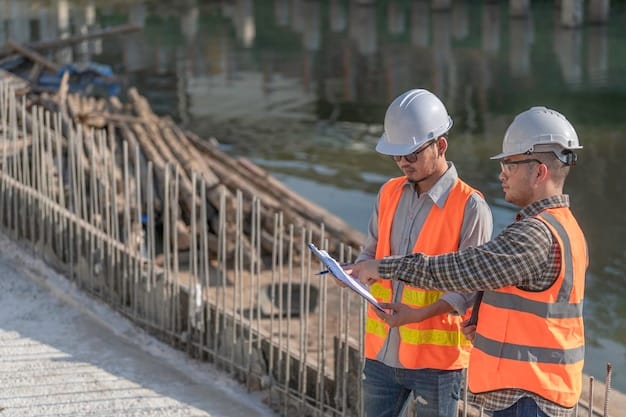Infrastructure Bill: Opportunities for US Construction Businesses

The new Federal Infrastructure Bill presents significant opportunities for US construction businesses through increased funding for infrastructure projects like roads, bridges, and broadband, driving demand and offering growth potential.
The passage of the new Federal Infrastructure Bill marks a pivotal moment for the US construction industry. With billions of dollars allocated to rebuild and modernize the nation’s infrastructure, construction businesses are poised to experience unprecedented growth and opportunity. Let’s explore how the **new Federal Infrastructure Bill is creating opportunities for US construction businesses**.
Understanding the Infrastructure Bill
The Infrastructure Investment and Jobs Act (IIJA), commonly known as the Infrastructure Bill, is a comprehensive piece of legislation aimed at revitalizing America’s aging infrastructure. It allocates significant funding across various sectors.
Key Components of the Bill
The bill addresses critical areas such as transportation, broadband internet access, and utilities.
- Transportation: Funds are earmarked for repairing and upgrading roads, bridges, and public transit systems.
- Broadband: Investments are aimed at expanding broadband access to underserved communities.
- Utilities: The bill supports upgrades to water and energy infrastructure, ensuring reliable services.
These components collectively create a landscape ripe with opportunities for construction businesses.
By understanding the various components of the Infrastructure Bill, construction companies can strategically position themselves to take advantage of the upcoming projects, fostering growth and innovation.
The Impact on Construction Businesses
The influx of federal funding is set to transform the construction industry, leading to increased project volume and demand for skilled labor. This presents both challenges and opportunities for businesses.

Increased Project Volume
With more funding available, the number of infrastructure projects is expected to rise significantly.
This surge in projects translates to more contracts and revenue opportunities for construction firms, large and small.
Demand for Skilled Labor
The increased project volume will drive up demand for skilled construction workers.
- Addresses labor shortages
- Creates job opportunities in construction and related fields
By strategically addressing labor shortages and embracing technological advancements, construction businesses can optimize their operations and capitalize on the opportunities presented by the Infrastructure Bill.
Navigating Funding Opportunities
Accessing the allocated funds requires a strategic approach. Businesses need to understand the application process and eligibility criteria.
Understanding the Application Process
Navigating the bureaucratic processes can be daunting, but essential.
It’s crucial to: research available grants, understand eligibility requirements, and prepare comprehensive applications.
Strategic Partnerships
Collaborating with other firms can enhance capabilities and increase chances of securing contracts.
Building strong relationships with government agencies and industry partners is also vital to accessing information and support.
Construction businesses should focus on transparent communication, ethical practices, and a commitment to delivering high-quality work to establish a strong reputation and foster long-term partnerships.

Technological Advancements in Construction
Embracing technology is crucial for improving efficiency and competitiveness in the construction industry.
Adopting Innovative Solutions
Technology can streamline workflows, reduce costs, and improve safety.
- BIM (Building Information Modeling): Enables detailed 3D modeling and collaboration.
- Drones: Facilitate site surveys, inspections, and progress monitoring.
- AI and Machine Learning: Optimize project scheduling and resource allocation.
Investing in these technologies can significantly enhance project outcomes.
Construction businesses can harness the power of data analytics, IoT, and augmented reality to create smarter, safer, and more sustainable construction practices.
Sustainability and Green Initiatives
The Infrastructure Bill prioritizes sustainable and environmentally friendly construction practices. Businesses that adopt green initiatives will gain a competitive edge.
Incorporating Green Practices
Sustainable construction methods are becoming increasingly important.
This includes:
- Using eco-friendly materials.
- Reducing waste.
- Implementing energy-efficient designs.
These practices not only benefit the environment but also enhance a company’s reputation.
By embracing sustainability, construction businesses can create a positive impact on the environment, contribute to a greener future, and align with the goals of the Infrastructure Bill.
Challenges and Mitigation Strategies
Despite the opportunities, construction businesses face challenges such as rising material costs and supply chain disruptions. Developing mitigation strategies is crucial for success.
Addressing Material Costs
Fluctuations in material prices can impact project budgets.
To mitigate this risk: negotiate favorable contracts with suppliers, explore alternative materials, and implement efficient inventory management practices.
Managing Supply Chain Disruptions
Supply chain issues can cause delays and increase costs.
Diversifying suppliers, building contingency plans, and closely monitoring global events can help mitigate these disruptions.
By staying adaptable, proactive, and resilient, construction businesses can overcome challenges and thrive in the evolving industry landscape.
| Key Highlights | Brief Description |
|---|---|
| 💰 Funding Boost | Bill provides significant resources for infrastructure projects. |
| 🛠️ Skilled Labor Demand | Increased construction requires more skilled workers. |
| 🌿 Sustainability Focus | Emphasis on green and eco-friendly construction methods. |
| 🚧 Project Volume Increase | More infrastructure projects lead to more opportunities. |
Frequently Asked Questions (FAQ)
▼
The main goal is to modernize and improve the United States’ aging infrastructure, including transportation, broadband, and utilities.
▼
It provides increased funding for numerous construction projects, creating more contracts and revenue opportunities for construction businesses.
▼
Challenges include rising material costs, supply chain disruptions, and a shortage of skilled labor to meet the increased project demands.
▼
Understanding the application process, forming strategic partnerships, and building robust relationships with government agencies are crucial steps.
▼
The bill prioritizes sustainable practices, meaning companies that adopt green initiatives gain a competitive advantage and contribute to environmental preservation.
Conclusion
The new Federal Infrastructure Bill represents a transformative opportunity for US construction businesses. By understanding the bill’s components, addressing challenges proactively, and embracing technological advancements and sustainable practices, businesses can position themselves for significant growth and contribute to rebuilding America’s infrastructure.





